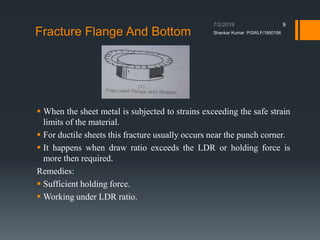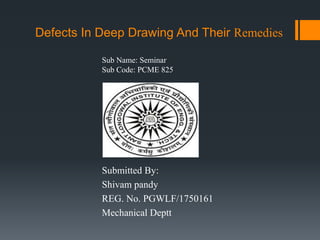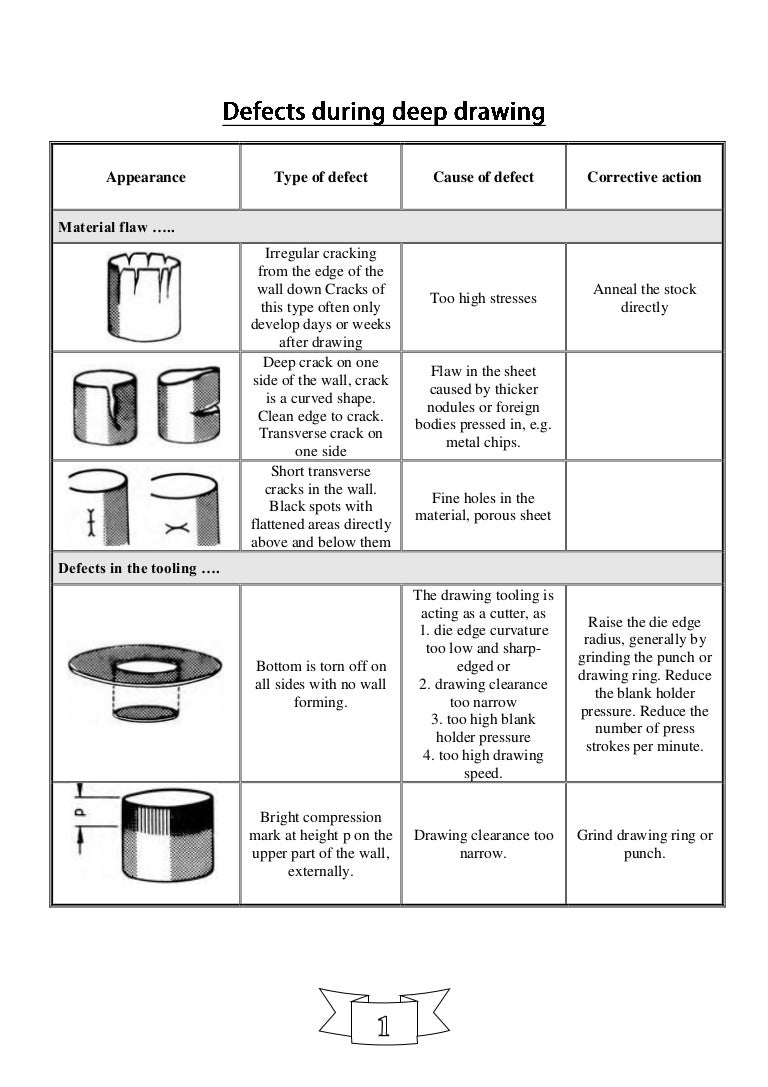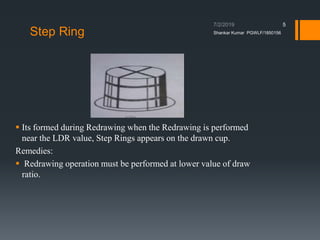What is the Defects In Deep Drawing Manufacturing. A number of defects may occur in deep-drawn parts.
State of the art.
. Author links open overlay panel Anubhav Singh a Shamik Basak a Lin Prakash PS. Our expert engineers prepare each metal punching blank in advance of the deep drawing process to ensure that the results are free from tears and other defects. In addition wrinkling may occur in the flange area in sheet spinning along the feeding direction of a flat strip under extrusion and in the circumferential direction of an annular thin film under torque.
Mostly used lubricants in deep drawing process are mineral oils soap solutions and heavy duty emulsions. Deep drawing is a form of metal stamping where the depth of the draw is typically greater than its diameter. Scratches Heavy scratches over the drawn cup may appear due to appearance of yield point phenomenon in the material.
The main defects of deep drawn parts are wrinkling andor necking. Earing is a result of non-uniform flow of material into the die cavity from different anisotropy directions of the sheet. The description of such defects is discussed below.
Knowledge about the ear formation in deep drawing allows a prior modification of the process. Develop defects if the process parameters are not selected properly. For sheets in the deep-drawing process wrinkling is the one of the most commonly seen defects and can take place in both the side-wall and flange area.
Deep drawing is a sheet metal forming process in which a sheet metal blank is radially drawn into a forming die by the mechanical action of a punch. Grain structure should be refined before deep drawing. Deep drawn stainless steel.
The most common defects in deep drawing operations are wrinkling galling orange peeling earing and tearing. This is one of the most common deep draw problems. Wrinkling and necking define the limits of the deep drawing process.
Potential causes and remedies are also provided. Steel material must be consumed within the strain aging time of material. Defects in deep-drawn cylindrical cups.
Failure of sheet metal parts during deep drawing processes usually takes place in the form of wrinkling or tearing. The following is a brief description of commonly found defects. Excessive thinning in areas of the sheet metal is also an unwanted defect.
These two defects ie. Up to 10 cash back The workpiece material used in a deep drawing process is anisotropic in nature due to a prior thermomechanical treatment. The wrinkling defects are a kind of buckling of the undrawn part of the blank.
Shankar Kumar PGWLF1850156 8 9. - deep drawn stamping parts. This is achieved by.
On the other hand necking is due to the excessive radial tensile stress. This defect is caused by the excessive compressive stresses if the slenderness ratio is higher than a certain value. Defects In Deep Drawing Tearing- Maximum thinning of the cup wall occurs near the base so tearing of the sheet metal is most likely to occur in this region even if the stress is originating somewhere else Wrinkling may often occur if the blankholder force is too low Excessive thinning in areas of the sheet metal Earing that is the formation of wavy edges at the.
The following is a list of common problems that may be encountered when deep drawing cyclindrical cups. It is thus a shape transformation process with material retention. 2 71 Over forming is a known solution for springback Splitting tearing is another defect type present in which is based on providing compensation in the the forming of AHSS from necking that starts from.
A major defect which affects the quality of the deep drawn cups is the occurrence of a wavy edge at the top commonly referred to as the earing defect. If this is too small too large or uneven the material can be cracked during drawing. Fracturing of the metal during the draw process can be caused by several issues although the most common is the clearance between the punch and the die.
One of the primary defects that occurs in deep drawing operations is the wrinkling of sheet metal material generally in the wall or flange of the part. Sipxmach is a deep draw metal stamping leading manufacturer for the aerospace communications industrial lighting medical military and furniture sectors. Defects that occur during deep drawing of sheet metal can be controlled by careful regulation of process factors.
Defects and Remedies in Stamping of Advanced High Strength Journal of Modern Mechanical Engineering and Technology 2014 Vol. Defects in Deep Drawing process. Therefore it is important to optimize the process parameters to avoid defects in the parts and to minimize production cost.
Earing is one of the major defects observed in a deep drawing process due to the anisotropic nature of the sheet material. Their occurrence is related to numerous factors such as blank hardness lubrication system quality of the die surface grain size and anisotropy of the drawn material holding down pressure and clearance between the punch and die. The flange of the blank undergoes radial drawing stress and tangential compressive stress during the stamping process which sometimes results in wrinkles.
Deep drawing mechanism parameters defects and recent results. Shankar Kumar PGWLF1850156 7 8. Tearing is one of the most common defects.
The process is considered deep drawing when the depth of the drawn part exceeds its diameter. Many variables affect the failure these. Metal fractures very early in the.
Reducin g the grain s ize prior t o drawing e ither by heat treatment or by adding grain refining the grains. A Gour Gopal Roy b Maha Nand Jha c Martin Mascarenhas c Sushanta Kumar Panda a. Figure 12 shows the type of defects that may be found after drawing cups.
In practice it is possible to produce long narrow cylindrical parts with a length that is significantly greater than the outside diameter of the part. Lubrication lowers the forces increases draw ability and reduces defect in the part and wear on the tooling. The following metals are currently used to manufacture products through deep drawing Alloy Aluminum Brass Bronze Cold rolled steel Copper Invar Iron Kovar Molybdenum Nickel Silver Stainless steel Tungsten 19.
WRINKLES Wrinkles - caused due to excessive clearance between the punch and die. Deep drawn low carbon steel. Additional deep drawn metal.
Defects in Deep-Drawn Parts. It does not provide on punch because friction between punch and blank improves draw ability by reduce tensile stress. The pattern of deformations in deep drawing.
Wrinkling usually occurs at the flange region by excessive compressive stresses leading to local buckling of the sheet. Prediction of earing defect and deep drawing behavior of commercially pure titanium sheets using CPB06 anisotropy yield theory.

Pdf Deep Drawing Mechanism Parameters Defects And Recent Results State Of The Art

Defects In Deep Drawing And Their Remedies

Defects In Deep Drawing And Their Remedies

Defects In Deep Drawing And Their Remedies

Defects In Deep Drawing And Their Remedies

All Defect Of Deep Drawing Process

Defects In Deep Drawing And Their Remedies

Pdf Prediction Of Forming Defects In Deep Drawing Process By Finite Element Simulation
0 comments
Post a Comment